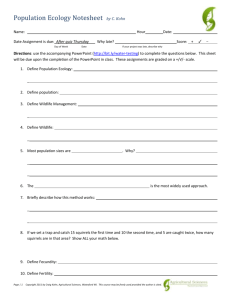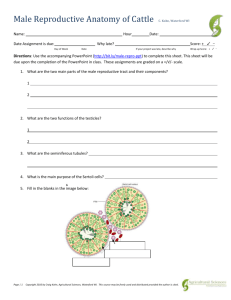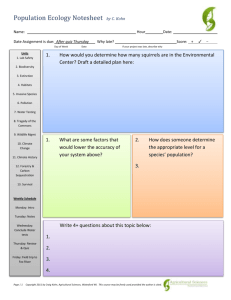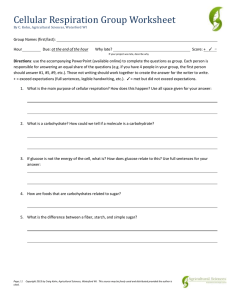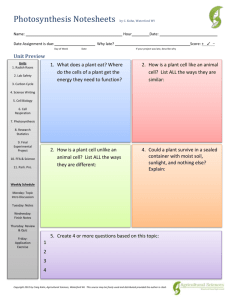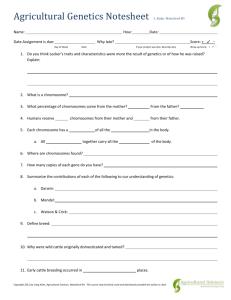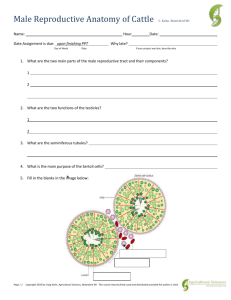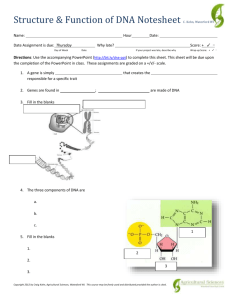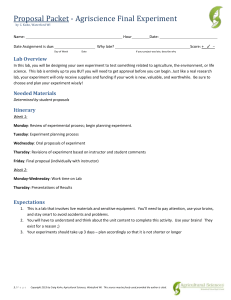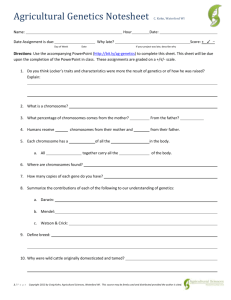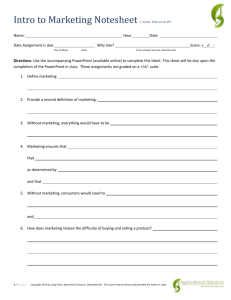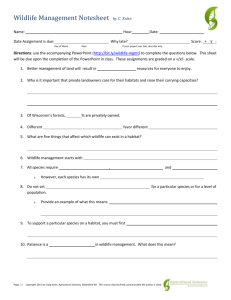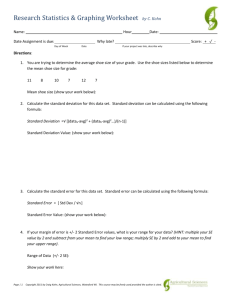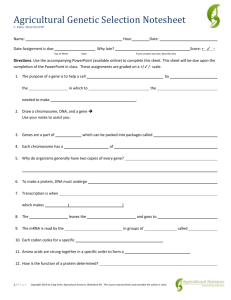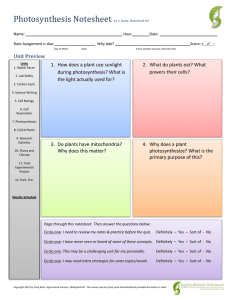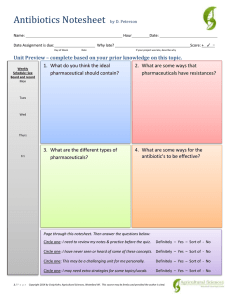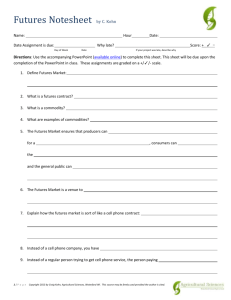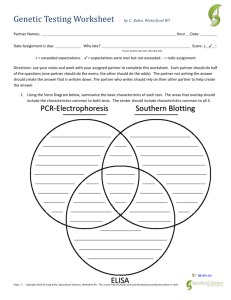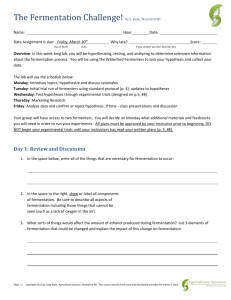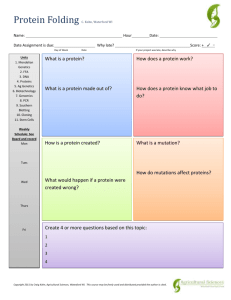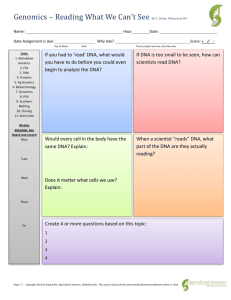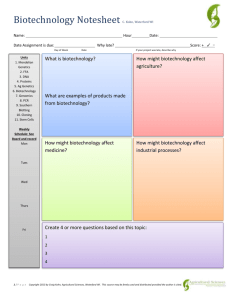Notesheet
advertisement
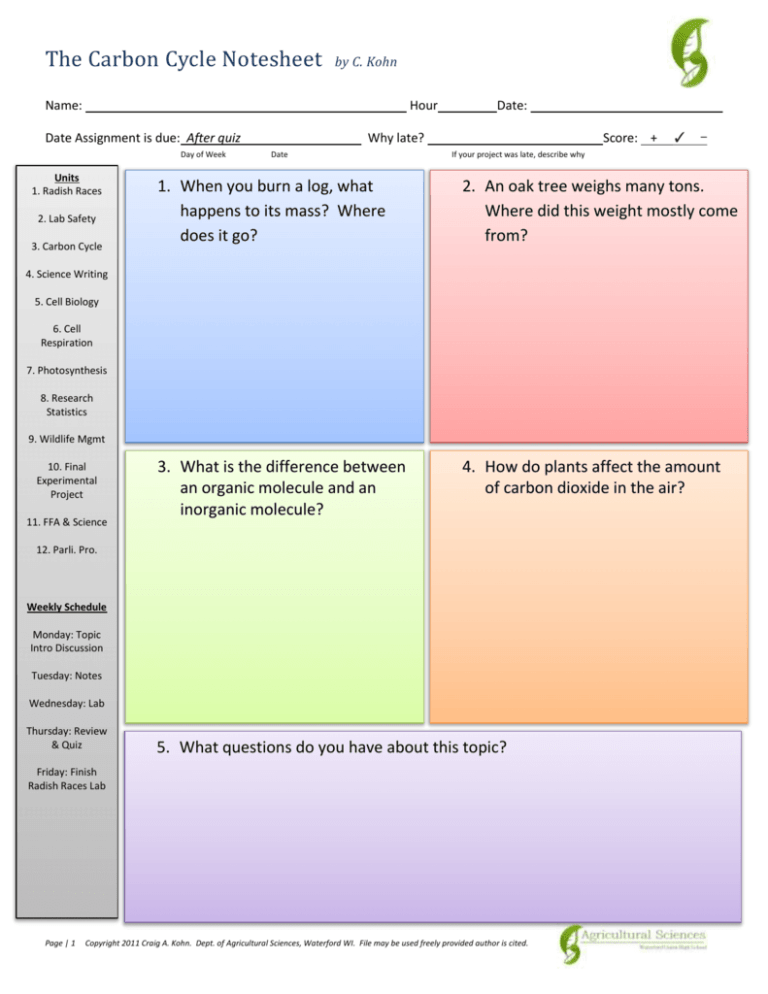
The Carbon Cycle Notesheet by C. Kohn Name: Hour Date Assignment is due: After quiz Day of Week Units 1. Radish Races 2. Lab Safety 3. Carbon Cycle Date: Why late? Date Score: + ✓ - If your project was late, describe why 1. When you burn a log, what happens to its mass? Where does it go? 2. An oak tree weighs many tons. Where did this weight mostly come from? 3. What is the difference between an organic molecule and an inorganic molecule? 4. How do plants affect the amount of carbon dioxide in the air? 4. Science Writing 5. Cell Biology 6. Cell Respiration 7. Photosynthesis 8. Research Statistics 9. Wildlife Mgmt 10. Final Experimental Project 11. FFA & Science 12. Parli. Pro. Weekly Schedule Monday: Topic Intro Discussion Tuesday: Notes Wednesday: Lab Thursday: Review & Quiz 5. What questions do you have about this topic? Friday: Finish Radish Races Lab Page | 1 Copyright 2011 Craig A. Kohn. Dept. of Agricultural Sciences, Waterford WI. File may be used freely provided author is cited. Notes C. Kohn, Agricultural Sciences - Waterford WI Directions: use the accompanying PowerPoint (http://bit.ly/carboncyclenotes) to complete the questions below. These assignments are graded on a + ✓- scale 1. The carbon cycle is a term for the process in which 2. For example, plants absorb from the and convert it into 3. When plants are consumed or decomposed, the plant matter is converted into 4. During photosynthesis, plants assemble organic versions of carbon (including ) using 5. This process of assembling organic molecules of is powered by 6. When the plant begins to (such as in autumn), soil organisms break down the back into 7. In the carbon cycle, the carbon always stays – it is neither . Carbon can only change what it is 8. In the atmosphere, we typically see carbon as version of carbon (it is not part of something . This is the ). 9. Organic versions of carbon include: , and 10. Cellulose is most commonly found in a plant’s (Hint: look at the picture on the side of this slide showing glucose and cellulose molecules) 11. True or false: can’t change the amount of carbon that exists. Explain: 12. Photosynthesis Page | 2 the amount of Copyright 2011 Craig A. Kohn. Dept. of Agricultural Sciences, Waterford WI. File may be used freely provided author is cited. in the air. 13. , and increase the amount of carbon dioxide in the air. 14. Soil works as a sort of in which the can take place. 15. Along with ocean water, soil serves as a major regulator of carbon by… 1. 2. 3. 16. Normally, the carbon cycle keeps itself a. Inorganic carbon is used by plants to create b. Organic forms of carbon convert back into 17. Today, however, the carbon cycle is not when they are consumed or decomposed . The levels of atmospheric carbon have risen to the highest levels in recent geological history at an 18. On the graph below, draw a horizontal line showing where atmospheric CO2 levels are today. Page | 3 Copyright 2011 Craig A. Kohn. Dept. of Agricultural Sciences, Waterford WI. File may be used freely provided author is cited. Unit Wrap-up C. Kohn, Agricultural Sciences - Waterford WI Name: Hour Date Assignment is due: Thursday Day of Week Date: Score: + ✓ - Why late? Date If your project was late, describe why 1. Write the 3 topics that you found least easy to understand in this unit: 1_ 2_ 3_ 2. What are the 5 things you most need to review before taking your next quiz? 1_ 2_ 3 4_ 5_ 3. Create 3 high-level questions related to this material: 1_ 2_ 3_ 4. List 6 vocabulary words that you did not know before or have almost never used before: 1_ 2 3 4 5 6 5. What is a specific strategy that you have for remembering a specific item from this unit? _ A strategy is a mnemonic, rhyme, analogy, or other brain-based strategy. It is not an activity such as reviewing your notes, making cards, studying hard, etc. Page | 4 Copyright 2011 Craig A. Kohn. Dept. of Agricultural Sciences, Waterford WI. File may be used freely provided author is cited.
